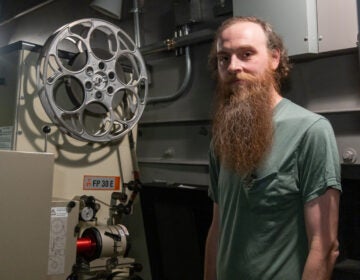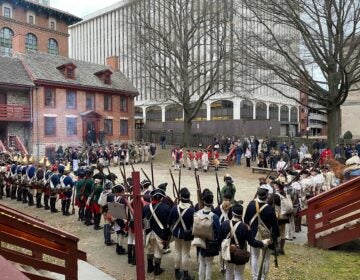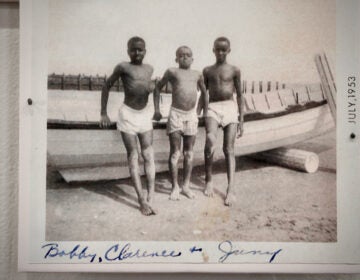Blazing a trail for African-American racers
Leonard Miller’s first car was a 1940 Ford Club Coupe, a chop-top convertible that he modified with a Mercury motor and a transmission pulled from a Lincoln.
Listen 6:22-
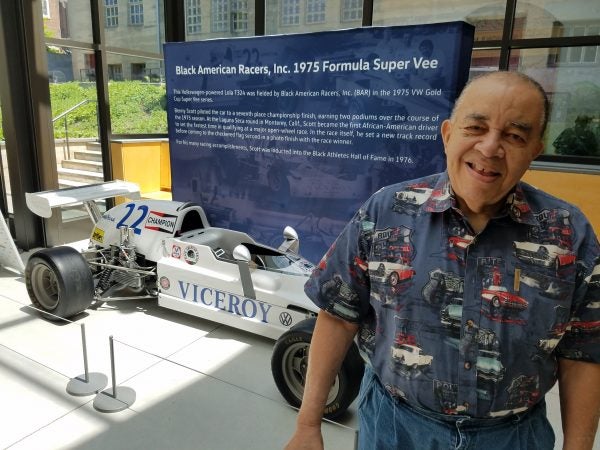
Leonard Miller at the Mercer Museum, with the Formula Vee car his team – the Black American Racers – raced. (Peter Crimmins/WHYY)
-

The founders of the Black American Racing Association (from left) Leonard Miller, Malcolm Durham, Wendell Scott and Ronald Hines. (Courtesy Leonard Miller)
-
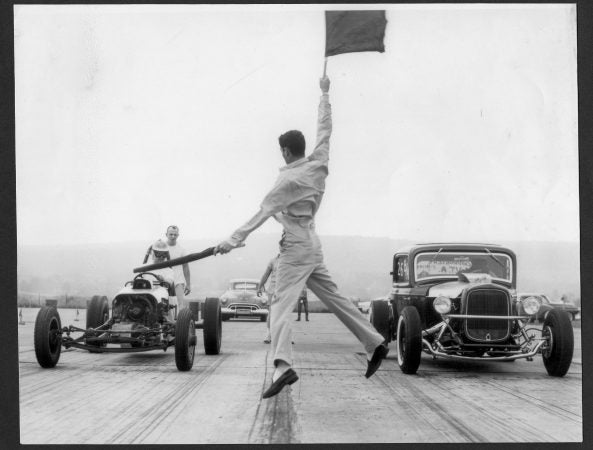
The starting flag at Convair Field speedway in Allentown in 1956. (Courtesy Joseph McNally)
-

A Formula One car is on display at the Mercer Museum. (Peter Crimmins/WHYY)
“Auto racing started five minutes after the second car was built.”
Henry Ford is believed to have come up with that genesis statement, and it might be true. But, in Pennsylvania, the first sanctioned race was on May 15, 1955, at Convair Field, an unused airfield near Allentown where local hot-rodders liked to bring their souped-up jalopies.
The Lehigh Valley Timing Association got the backing of the National Hot Rod Association to hold monthly drag races. The events were an instant hit: That first race attracted about 4,000 people to watch more than 100 cars compete. By the end of the summer, the number of racers and fans had doubled.
It didn’t last. A year later complaints of noise and delinquency squashed Convair. By then, the rubber was on the track: Speedways and drag strips started popping up all over, including several in and near Bucks County — Hatfield, Langhorne (called The Big Left Turn for being a near-perfect circle), and Vargo.
“Vargo was such an ideal circumstance,” said Leonard Miller, who raced on those speedways in the 1960s and would become a pioneer in African-American motorsports.
“They were all Army vets like myself. Everyone got along. They were mature. You didn’t have any racial animosities or silly stuff going on. These guys were like real men,” he said. “You’re going close to dying, putting it all on the line. That was more important than anything else.”
Right now, the Mercer Museum in Doylestown, Pennsylvania, is exhibiting cars, gear, and ephemera from the heyday of drag racing in Bucks County. “Racing: A Need for Speed,” tracks the local history of not just motorsports, but bicycle racing, horse racing, track and field.
Miller grew up on the Main Line, his mother doing domestic work for wealthy families who put money into horses and cars. He remembers being 5 years old in 1939 and seeing the most beautiful machines in the world.
“I learned how wonderful the world was,” he recalled. “When they had a Memorial Day parade – this was before World War II – you’d see Stutz Bearcats, Cords, Duesenbergs in yellow, red and blue. I was taken in by it.”
Miller’s first car was a 1940 Ford Club Coupe, a chop-top convertible that he modified with a Mercury motor and a transmission pulled from a Lincoln. He got a lot of help from the local junkyard run by a guy named Bill Jones.
“Bill Jones had a junkyard on Route 30 coming out of Paoli. He was a big African-American numbers writer and gambler. He had the junkyard as a front,” said Miller. “He went to Eastern State Penitentiary and served two years. When he came out, no one in the black community would speak to him.”
Miller’s father treated Jones with civility and taught his son to do the same. When Miller came around to look for parts for his coupe, he would peek into Jones’ junkyard shack to see a circle of known Philadelphia mobsters playing high-stakes poker in the back.
Jones would wave him on, telling him to take anything he wanted out of the rusty cars outside because he was good people.
“He said, ‘You always spoke to me, young man, and your dad always treated me right,’ ” said Miller.
From scrappy beginnings on Bucks County’s dirt tracks to the winner’s circle at NASCAR, a black man’s success in a predominately white sport relies on 1,000 hands. In his 2004 autobiography, “Silent Thunder: Breaking Through Cultural, Racial, and Class Barriers in Motorsports,” Miller describes getting mechanical help from gearheads at the local gas station, to later forming a professional group – the Black American Racers Association – in order to develop black drivers for the big leagues.
With an eye for talent and a head for numbers, he eventually gave up the driver’s seat.
“My brother Dexter said I was more valuable because no one else could do what I could do,” he said. “I can write a proposal. I can work on the car. I can drive if necessary. The missing element was management. No one else could do that.”
Running into roadblocks
As the director of professional racing team, Miller’s chief duty was finding money. Money is critical to car racing, moreso than most other sports. A driver needs nerves of steel, skills under pressure, and aggressive strategy, but he’s nothing without a really fast car.
“It’s very hard for an American corporation to write a check for a million dollars to a black racer. Very hard,” said Miller, who has had countless meetings with corporate executives. He says he is often sent to “diversity,” the sponsorship arm that gives to African-American causes.
Instead of competing for corporate sponsorship dollars against Mario Andretti or Dale Earnhardt, Miller said he often is vying for corporate money earmarked for African-American issues, competing against the legacies of Martin Luther King Jr. or Frederick Douglass.
In 1975, Viceroy cigarettes – at the time Miller’s lifeline to the Indy 500 — came under pressure to give raises to its striking workers. There was no money leftover to sponsor a black Formula Vee racing team.
“That decision pushed black racing development back 20 years,” Miller wrote in his biography.
A few years later, Miller swallowed another bitter pill when he switched to NASCAR. That meant redirecting resources away from opened-wheel Formula Vee cars and toward stock cars.
“NASCAR in 1979 became the series that TV people liked, the series Americans gravitated to,” he explained. “It was a closed-circuit track, so you can put TV cameras everywhere. There were personalities – drivers fighting all the time, what I call hillbilly talk – so NASCAR took off.”
“We had to switch over to NASCAR because there was no sponsorship in open-wheel cars,” he said. “That’s the only reason we did it. Open-wheel racing is the best racing in the world.”
Miller does not have many kind words for NASCAR.
“NASCAR is interested in a plantation system of bringing black up through the ranks,” he said. “They select certain types of blacks for certain reasons. The drivers they like are the ones they can run out on stage and parrot anything they say. The black driver development has failed.”
“They also do that with the white drivers. NASCAR operates like the antebellum slave era, before the Civil War. It’s like a political organization with rules that change every day based on how the plantation needs to run,” said Miller.
The story of Miller and his struggles in black professional motorsports is the subject of an upcoming documentary film, based on “Silent Thunder,” which is now being finalized for a possible premiere this fall at the Telluride Film Festival.
On Saturday, Miller and the original members of the Black American Racing Association will reunite at the Mercer Museum for a discussion about African-American auto racing.
WHYY is your source for fact-based, in-depth journalism and information. As a nonprofit organization, we rely on financial support from readers like you. Please give today.



